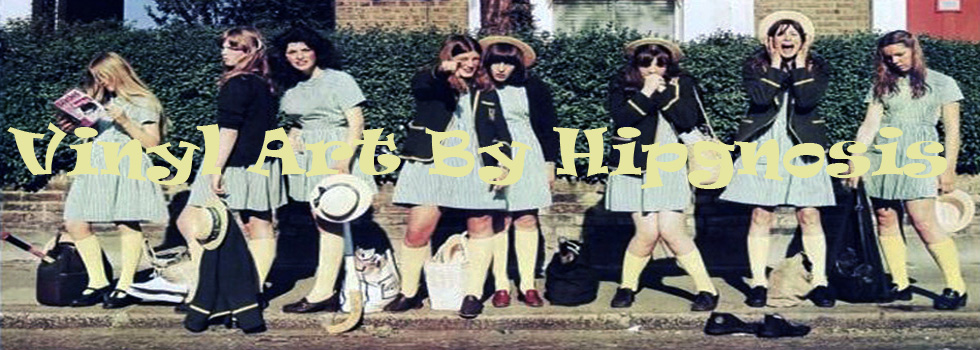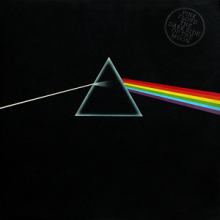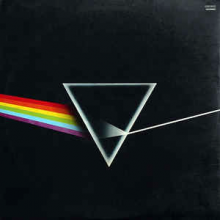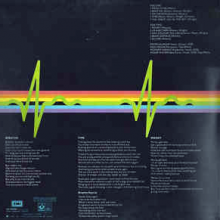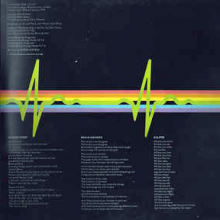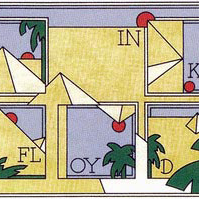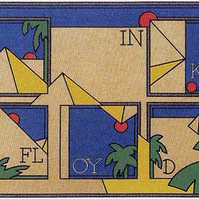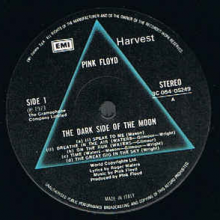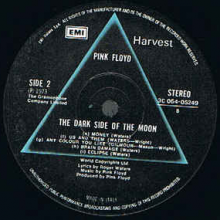Biography
Pink Floyd were an English rock band formed in London. They achieved international acclaim with their progressive and psychedelic music. Distinguished by their use of philosophical lyrics, sonic experimentation, extended compositions and elaborate live shows, they are one of the most commercially successful and influential groups in the history of popular music. Pink Floyd were founded in 1965 by students Syd Barrett on guitar and lead vocals, Nick Mason on drums, Roger Waters on bass and vocals, and Richard Wright on keyboards and vocals. They gained popularity performing in London’s underground music scene during the late 1960s, and under Barrett’s leadership released two charting singles and a successful debut album, The Piper at the Gates of Dawn (1967). Guitarist and vocalist David Gilmour joined in December 1967; Barrett left in April 1968 due to deteriorating mental health. https://en.wikipedia.org/wiki/Pink_Floyd
Album & Cover
The Dark Side of the Moon is the eighth studio album by the English progressive rock band Pink Floyd. Originally released on 1 March 1973, on the label Harvest. It built on ideas explored in the band’s earlier recordings and live shows, but lacks the extended instrumental excursions that characterised their previous work following the departure in 1968 of founder member, principal composer, and lyricist, Syd Barrett. The Dark Side of the Moon explores themes including conflict, greed, the passage of time, and mental illness, the latter partly inspired by Barrett’s deteriorating mental state. Engineer Alan Parsons was responsible for many of the album’s most notable sonic aspects and the recruitment of non-lexical singer Clare Torry. The album’s iconic sleeve, designed by Storm Thorgerson, depicts a prism dispersing light into color and represents the band’s stage lighting, the record’s lyrical themes, and keyboardist Richard Wright’s request for a “simple and bold” design. The Dark Side of the Moon was an immediate success; it topped the Billboard chart for one week and remained in the charts for 741 weeks from 1973 to 1988. Richard Wright, talking about the album said, “It’s changed me in many ways, because it’s brought in a lot of money, and one feels very secure when you can sell an album for two years. But it hasn’t changed my attitude to music. Even though it was so successful, it was made in the same way as all our other albums, and the only criterion we have about releasing music is whether we like it or not. It was not a deliberate attempt to make a commercial album. It just happened that way. We knew it had a lot more melody than previous Floyd albums, and there was a concept that ran all through it. The music was easier to absorb and having girls singing away added a commercial touch that none of our records had” https://en.wikipedia.org/wiki/The_Dark_Side_of_the_Moon
Richard Wright instructed them to come up with something “smarter, neater – more classy”. The prism design was inspired by a photograph that Storm had seen during a brainstorming session with Po. The artwork was created by their associate, George Hardie. Hipgnosis offered the band a choice of seven designs, but all four members agreed that the prism was by far the best. The final design depicts a glass prism dispersing light into color. The design represents three elements; the band’s stage lighting, the album lyrics, and Wright’s request for a “simple and bold” design. The spectrum of light continues through to the gatefold – an idea that Roger Waters came up with. Added shortly afterwards, the gatefold design also includes a visual representation of the heartbeat sound used throughout the album, and the back of the album cover contains Thorgerson’s suggestion of another prism recombining the spectrum of light, facilitating interesting layouts of the sleeve in record shops. The light band emanating from the prism on the album cover has six colours, missing indigo compared to the traditional division of the spectrum into red, orange, yellow, green, blue, indigo and violet. Inside the sleeve were two posters and two pyramid-themed stickers.
Cover Location: Hipgnosis Studio, London, UK
Who Did What: Graphics – G. Hardie. Cover Design – Hipgnosis/Pink Floyd
Label: Harvest SMAS-11163(US), Harvest SHVL804(UK)
Source: Vinyl. Album. Cover. Art, The Complete Hipgnosis Catalogue: Aubrey Powell
Tracklist
| Side One Speak To Me Breathe On The Run Time The Great Gig In The Sky |
Side Two Money Us And Them Any Colour You Like Brain Damage Eclipse |
Credits
David Gilmour – Vocals; Guitars
Nick Mason – Percussion
Richard Wright – Keyboards; Vocals
Roger Waters – Bass guitar; vocals
Dick Parry – saxophone on “Us and Them” and “Money”
Clare Torry – vocals on “The Great Gig in the Sky”
Doris Troy – backing vocals
Lesley Duncan – backing vocals
Liza Strike – backing vocals
Barry St. John – backing vocals
Alan Parsons – Engineer
Peter James – assistant (incorrectly identified as “Peter Jones” on first US pressings of the LP)
Chris Thomas – mix supervisor
1975 Comic Book: Click on the cover to view.
 For all their serious brooding and biting digs at the establishment, the members of Pink Floyd were not above having a little fun with their image. Take this 1975 comic book, created by their record cover designer Storm Thorgerson’s company Hipgnosis for the Dark Side of the Moon tour. A “Super, All-Action Official Music Programme for Boys and Girls,” the 15-page oddity—pitched, writes Dangerous Minds, “somewhere halfway between ‘professional promotional item’ and ‘schoolboy’s notebook scribbling’”—includes several short comic stories: Roger (“Rog”) Waters is an “ace goal-scorer” for the “Grantchester Rovers” football club. Floyd drummer Nick Mason becomes “Captain Mason, R.N.,” a “courageous and smart” WWII naval hero, and David Gilmour gets cast as stunt cyclist “Dave Derring.” The juiciest part goes to keyboardist Richard Wright, whose salacious exploits as high roller “Rich Right” complete the proto-Heavy Metal vibe of the whole thing.
For all their serious brooding and biting digs at the establishment, the members of Pink Floyd were not above having a little fun with their image. Take this 1975 comic book, created by their record cover designer Storm Thorgerson’s company Hipgnosis for the Dark Side of the Moon tour. A “Super, All-Action Official Music Programme for Boys and Girls,” the 15-page oddity—pitched, writes Dangerous Minds, “somewhere halfway between ‘professional promotional item’ and ‘schoolboy’s notebook scribbling’”—includes several short comic stories: Roger (“Rog”) Waters is an “ace goal-scorer” for the “Grantchester Rovers” football club. Floyd drummer Nick Mason becomes “Captain Mason, R.N.,” a “courageous and smart” WWII naval hero, and David Gilmour gets cast as stunt cyclist “Dave Derring.” The juiciest part goes to keyboardist Richard Wright, whose salacious exploits as high roller “Rich Right” complete the proto-Heavy Metal vibe of the whole thing.
Perhaps most fun is a silly questionnaire called “Life Lines” that asks each band member about such trivia as age, weight, height, “philosophical beliefs,” “sexual proclivities,” “political leanings,” and “musical hates.” Most of the answers are of the flippant, smart-ass variety, but I think they’re all sincere when they name their favourite movies: Beyond the Valley of the Dolls, The Seventh Seal, Cool Hand Luke, and El Topo. I’ll let you figure out who chose which one. The penultimate page includes the lyrics to three new songs the band was working on at the time and playing live during the Dark Side of the Moon Tour: “Shine on You Crazy Diamond,” and two unreleased tracks, “Raving and Drooling” and “Gotta Be Crazy”—which later turned into “Sheep” and “Dogs,” respectively, on the Animals album.
